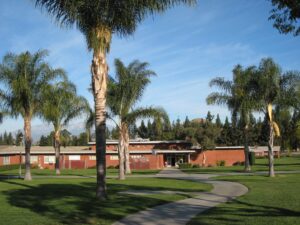 Incepted in 1953, California School for the Deaf, Riverside is a fully accredited ASL/English bilingual school serving 425 day and residential Deaf students ages 3-21 from Southern and Central California with local multi-district-based Parent Infant Program for students ages 18 months to 3 years old. Counseling, speech, audiology, assessment, behavior support, and occupational therapy are provided based upon student need. In addition, CSDR offers a full extra-curricular program including athletics, academic competitions, student organizations, and residential activities. Extended School Year is available for students that meet eligibility. Its Outreach Resource Center provides assessment, resources, and services to the community.
Incepted in 1953, California School for the Deaf, Riverside is a fully accredited ASL/English bilingual school serving 425 day and residential Deaf students ages 3-21 from Southern and Central California with local multi-district-based Parent Infant Program for students ages 18 months to 3 years old. Counseling, speech, audiology, assessment, behavior support, and occupational therapy are provided based upon student need. In addition, CSDR offers a full extra-curricular program including athletics, academic competitions, student organizations, and residential activities. Extended School Year is available for students that meet eligibility. Its Outreach Resource Center provides assessment, resources, and services to the community.
Prior to March 2020
Technology services had expanded in a gradual shift to CSDR being a synergized Apple and Microsoft school. Classroom desktop computers and personal iPads were issued to each student with school subscriptions to cloud services, a wide variety of educational technology software and apps that are visually accessible to foster continuous and equitable 21st century learning. Teachers and students had opportunities to communicate through various multi-media interactive online platforms, enabling students to access learning and direct communication with school staff and classmates outside the classroom. The school also consistently hosted on-site school events and workshops for families and community.
During March-June 2020
The sudden transition online was eased by the existing on-campus use of iPads, and online collaboration platform that combines chat, video meetings, file storage, and application integration. School staff rose to the challenge by surveying and supplying students and staff their own school-issued iPads for home. Local families and staff drove through to pick up devices and educational resources, and families who live far away received theirs by Fed-Ex mail. Additionally, school staff worked during spring break to prepare for resuming classes with transformations. CSDR expanded its website, social media, intranet and email content and communications to students and families with relevant updates, revised class schedules for online instruction, and resources.
Information was distributed in ASL and English on eLearning content and tips, public health, travel restrictions, local Deaf agencies, and free or reduced-cost services for free meal pick-up and Pandemic EBT free food debit cards, Internet, eLearning software, and eBooks. Inspirational and encouraging messages were distributed on external and internal online platforms. Most workshops and services resumed online. The school conducted IEP meetings on Zoom, preparing families in advance through technology trainings by phone call and online practice. The Superintendent also hosted live video interactive chats on school updates.
How the School Rose to the Challenge
Faced with urgency, a collaboration rose across departments and divisions to analyze and gather data on technology, survey staff and students in order to implement programming, schedule pick-up and delivery, create agreements, and provide continuous support for all students and staff to go digital in less than two weeks. To compensate for the incomplete schoolwide training and ability on the new online learning platforms, technology, IT, outreach, curriculum specialists, and JrNAD organization joined forces to supply tremendous support to teachers, students and families to walk through the Microsoft tutorials and implementation.
Throughout Distance Learning, students and staff experienced outstanding personal and professional growth and celebrated their learning and school spirit through student projects and videos, with embedding of voice, subtitles, and Spanish translation for families and the public. The end product was so successful that the Outreach Resource Center collaborated with California Department of Education in hosting a first time multiple-school joint webinar for school presenters to share strategies on educating, supporting and empowering Deaf students through Distance Learning, that brought in 13,000+ views and positive comments. In addition, new students have temporarily enrolled at CSDR to receive quality online services during quarantine.
Where the School is Now
Extended School Year is in session through continued eLearning. CSDR participated in a Riverside County taskforce to develop a guidebook for the safe opening of schools addressing important topics such as personal protective equipment. In addition, the Leadership team hosted a series of online meetings with staff and parent representatives to identify potential challenges with the reopening of school and operations based on the new guidebook and parent survey as tools for decision-making. CSDR is continuously communicating developments with staff, students, families, and community members and prepared to face reopening with several scenarios based on the wave of the pandemic.
Looking Ahead
School reopening will be challenging with students coming from 12 counties with varied and fluctuating reopening dates, with the consideration for COVID-19 related safety risks for residential students. CSDR will continue with online learning in the fall for the time being. Registration Day will be conducted by drive-thru to complete registration process, pick up iPads/curriculum materials, and communicate with school staff face-to-face. As soon as the physical reopening date of the school is determined, administrators will work together to plan the roll out for re-entry, that will include providing staff and student safety training prior to and upon their return.
Superintendent: Nancy Hlibok Amann, Ph.D.

